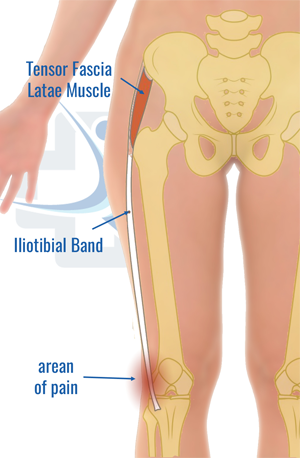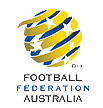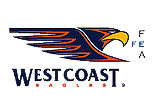Iliotibial Band (ITB) Friction Syndrome
What is the IT band / Iliotibial band / ITB?

The iliotibial band is a thick band of tissue that runs down the outside of the thigh. It starts above the hip joint and inserts just below the knee joint. This means that amount of tension in the ITB at any given time depends on the angle of both those joints as well as the pull of the muscles that attach to it (mainly the very strong gluteus maximus). It is a very important structure for stability of the hip and knee during weightbearing activities.
What causes ITB friction syndrome?
The knee has a bony prominence called the lateral femoral epicondyle (LFE). The ITB sits in-front of the LFE when the knee is straight and flicks behind it when the knee bends past a certain angle. This is completely normal. ITB friction syndrome is caused when this movement occurs with excessive ITB tension, excessive repetition or remains ‘perched’ over the LFE under tension for too long during the running stride.
What are the symptoms of IT band friction syndrome?
Not all cases of IT band friction syndrome are typical. The typical symptoms include lateral knee pain that comes on after a certain distance of running and then progressively worsens. Often it comes on earlier with successive runs. It can also be more severe with running downhill and usually it settles immediately at rest and is not present during other activities. Strangely it can be worse with steady running than sprinting.
ITB friction syndrome is notorious for also being atypical. Sometimes it hurts more with cycling or going upstairs than running and sometimes the pain is in the front or just below the knee.
The ITB can also cause friction up near the hip – for information on that condition click here for our article on hip bursitis.
The ITB doesn’t often cause pain in the middle of the lateral thigh and is often wrongly blamed in other conditions including stress fractures, referred hip pain and nerve entrapments.
How is ITB (or IT band) friction syndrome diagnosed?
When ITB friction syndrome is typical, it can be easily diagnosed with clinical tests by an expert Sport and Exercise Physician.
Occasionally, if it presents in an unusual way, further tests are required. ITB friction doesn’t always show up on a scan so the most accurate test can be an injection of a small amount of local anaesthetic immediately after the pain has been stirred up by activity. Sometimes your doctor might suggest a scan to rule out other conditions.
How is IT band (ITB) friction syndrome treated?
There are many elements to ITB friction syndrome that often need to be treated at once. Usually it occurs due to a biomechanical issue that needs to be addressed and this might involve releasing tension in the ITB or addressing your running gait, footwear or gluteal strength. Often inflammation is involved, and this normally responds very well to a corticosteroid (cortisone) injection. In cases that are 100% inflammatory, cortisone can lead to a very quick resolution but in other cases, where there is degeneration in the band, a longer period of rehab and load-modification is required.
Do I need to stop running if I have ITB friction syndrome?
Usually the aggravating activity needs to be ceased for a period of time but all other activities and cross-training that do not cause pain can be maintained.





















